Please Take Note: This is a review of the game’s final prototype. The art, game bits, and the rules discussed are all subject to change. The game is being reviewed on the components and the rules provided with the understanding that “what you see is not what you might get” when the game is published. If you like what you read and want to learn more, we encourage you to visit the game’s web page, or visit the Kickstarter campaign. Now that we have all that disclaimer junk out of the way, on with the review!
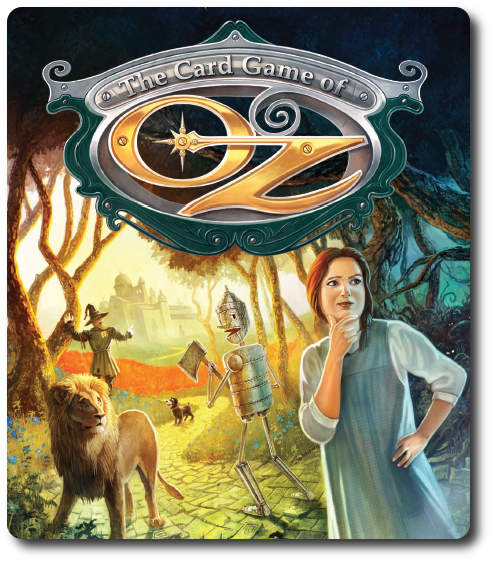
The Basics:
- For ages 8 and up (publisher suggests 14+)
- For 1 to 4 players
- Approximately 30 minutes to complete
Geek Skills:
- Active Listening & Communication
- Counting & Math
- Logical & Critical Decision Making
- Reading
- Pattern/Color Matching
- Strategy & Tactics
- Risk vs. Reward
- Hand/Resource Management
Learning Curve:
- Child – Moderate
- Adult – Easy
Theme & Narrative:
- Explore and rewrite the history of the Land of Oz!
Endorsements:
- Gamer Geek approved!
- Parent Geek approved!
- Child Geek approved!
Overview
Oz is not a happy fairy tale. Politics and intrigue are rampant as power struggles between opposing forces divides the land and its people. It is here that a young girl from Kansas first enters the story as a hapless traveler and later becomes Oz’s greatest hero. Lifted right from the pages of L. Frank Baum’s Oz books, the history of the land and its strange inhabitants are presented to the players to explore and rewrite as they see fit.
The Card Game of Oz, published by Game Salute, will reportedly be comprised of 4 Story Packs (preconstructed decks, 230 cards in total), 4 Title cards, 10 customized six-sided die (4 blue and 6 gold), and a first player marker. As this is a review of the game’s final prototype, we will not comment on the game component quality. However, the proposed artwork for the game is simply outstanding. Not included with the game, but necessary to play, are small counters to be used on some of the cards in the game. Pennies, small bits of paper, or Poker chips will work just fine.
But please do not use Cheetos.
Game Set Up
Note: The following game set up is for the standard 2-player game. The Game Variants section of this review will cover additional ways the game can be played.
To set up the game, first choose a Story Pack. The game comes with preconstructed Story Packs, but players can also build their own (this is covered in the Game Variants section). A Story Pack will contain Character cards, Object cards, Effect cards, and Event cards. When put together, these are referred to as the Library deck. A Story Pack will also contain Location cards that are larger than the other cards and are combined to create the Location Folio.
Second, shuffle the Location cards to create the Location Folio. This can be customized, as well, and represents the different places the players (referred to as “authors” in the game) will take their characters through. From the Location Folio deck, authors will take turns drawing and placing 3 Location cards face-down to their right from an agreed upon central position. In this way, the authors will build a single row of Location cards referred to as the “Storyline”. Once completed, each player will cap the row with a Title card on the left most Location card (based on the player’s position). The Title card represents not only the start of the Storyline, but also the final destination. From the author’s perspective, the Title card they placed at left is the starting position and they will be attempting to move Character cards to their right towards their opponent’s Title card. The remaining Location cards in the Location Folio are set aside and kept face-down within easy reach of all the players.
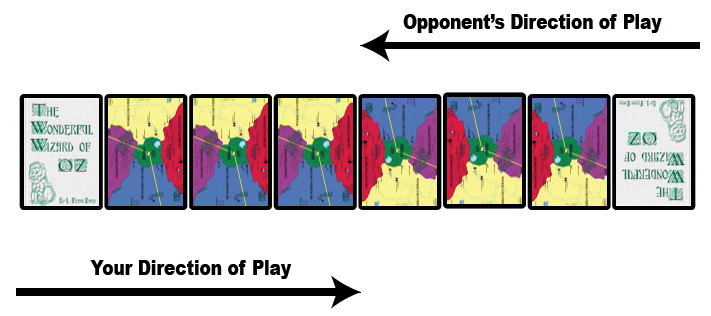
Third, place all the dice within easy reach of all the authors and shuffle the Library cards to create the Library deck. From the Library deck, each author will draw 5 cards to create their starting hand. The remaining cards in the Library deck are placed face-down and within easy reach of all the players. Reserve a space next to the Library deck for the archive. The archive the discard pile for Library cards.
That’s it for game set up! Determine who will go first and begin your journey through the Land of Oz!
A Quick Glimpse of the Cards
As this is a card game, it is rather important to know what each card type is. Each of the card types are summarized here.
Location Cards
These large cards represent the many different locals found in the Land of Oz. From the Yellow Brick Road that traverses the landscape to the Emerald City and beyond. The politics of each Location determine the inhabitants’ moral standing. These are Good, Neutral, and Evil, with each Location possibly granting a bonus or inflicting a penalty depending the characters who visit. At first, all Locations are “hidden” (face-down), but as the game progresses the Locations will be “discovered” (face-up). Additionally, Locations can change, reflecting the sometimes chaotic and mysterious Land of Oz.
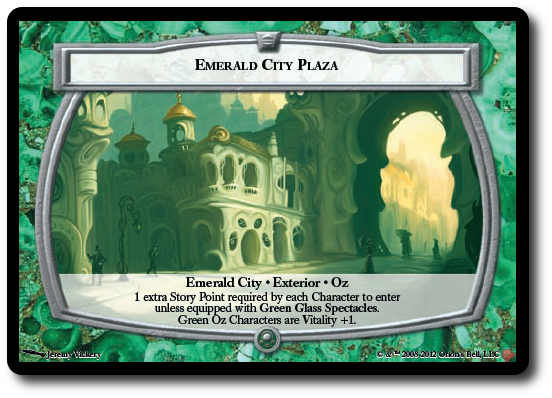
Character Cards
A story isn’t much fun without heroes, villains, and a large supporting cast. The Character cards represent both secondary and primary characters in the Oz stories. Authors do not own the Character cards, but they can control them and attempt to manipulate a Storyline through them. The more important the character, the more vitality points the character has. Vitality is not health (no characters die in the game), but the measurement used to express the character’s importance to the story. Some characters have control of magic and must be in play and under control of the author before spells from Event and Effect cards can be played. Some Characters can fly which allows the author who is controlling them to ignore all or just some of the text on a Location card.
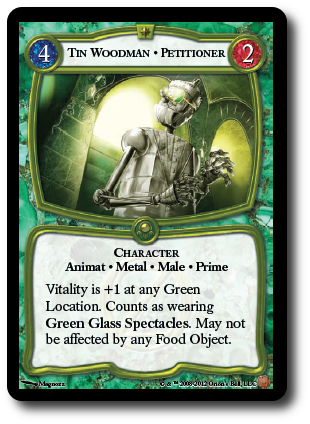
Object Cards
Oz is a land of magic and science, mixing together for create a whimsical world full of objects that can dazzle the mind. There are also, of course, very mundane objects available, and while not interesting to look at, they are still useful. Object cards can be tools to help characters overcome obstacles and trinkets that provide bonuses.

Event Cards
The Land of Oz is a strange and sometimes terrifying place. The many events that occur are represented by the Event cards that can be played to automatically influence the Storyline, saved for later, and even played face-down to keep opponent’s guessing! Keep in mind that this game is based on the books of Oz, and there is a dark undercurrent throughout those books. This is also reflected in the Event cards.
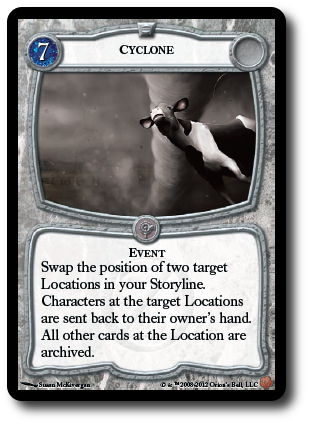
Effect Cards
The inhabitants of Oz are very diverse and their daily lives influence the land in which they live. The Effect cards represent the constantly blowing wind of change and unpredictability. Effects can be attached to specific cards and remain until archived (discarded) or simply take effect once played.
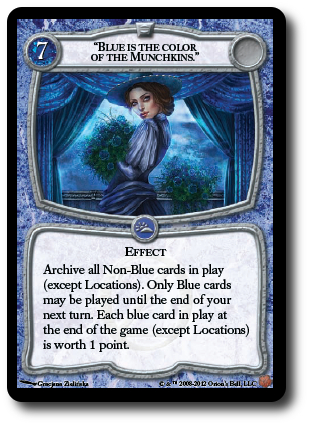
Follow the Yellow Brick Road
The game is played in a series of rounds. During each round, authors will take a single turn. During their turn, each author will complete three sequential steps. When completed, the next author has their turn. The steps are summarized here.
Step 1: Generate Story Points
Story Points (SP) are the currency used in the game that allow the authors to manipulate the story and forward the game. The author will take the 4 blue dice and add 1 gold die for every Character card they have on their side of the Storyline. Once the dice are rolled, the number of resulting Story Points are tallied and determine the author’s Story Points for their turn, but they can get more in the next step.
The maximum number of dice an author can ever roll at once during this step is 10.
Step 2: Perform Story Actions
Now the player performs actions to further their Storyline by spending their Story Points.
- 1 Story Point = Draw 1 card from the Library deck adding it to the author’s hand
- 1 Story Point = Move one Character card on the author’s Storyline to one Location card directly to the left or the right of the Character card’s current position. Note that some Location cards will require the author to pay more Story Points to enter and to exit them. If the author cannot pay the additional Story Points, the Character card cannot travel to that Location card.
- 2 Story Points = Select a discovered (face-up) Location card in the Storyline and replace it with a new Location card drawn from the Location Folio. The new Location card is placed face-up and any Effect and Events cards attached to the old Location card are archived (discarded), leaving only Character and Object cards. The replaced Location card is placed on the bottom of the Location Folio.
- X Story Points = Play a card from the author’s hand. If a card has a cost to play, it will be shown in the card’s upper left corner. The Story Point cost could be anywhere from zero to seven! When a card comes into play, authors should read the card’s game text out loud and check to see if the Location card it is placed on has any influence over the card in question, altering it.
There is no limit to the number of Story Actions the author can perform as long as they can pay for them using the Story Points. If the author didn’t roll enough during step 1, they can earn more by playing cards from their hand that award Story Points or by archiving (discarding) a card from their hand to roll 1 Gold die for every card archived. Any unspent Story Points are lost after the author has completed their turn.
Step 3: Bonus Movement
The final step allows the author to move each of the Character cards they currently control to one Location card directly to the left or the right of the Character’s currently location without using any Story Points. Again, some Location cards might require additional Story Points to be spent to enter and exit them. These must be paid using Story Points.
This ends the author’s turn. If at anytime the Library deck runs out of cards, the archived (discarded) cards are shuffled and placed face-down to create a new Library deck.
Ending the Story
The game continues until one of the authors moves a Character card with the keyword “Prime” to their opponents Title card (which, in a 2-player game, is to the far right side of the Storyline). The Title card is then flipped to show “The End”. This ends the author’s turn, but every author who has not yet taken a turn this round can now complete their turn. As far as movement goes, the Title cards are consider Location cards without movement restrictions.
The winner of the game is determined by each author adding the vitality of each of the Character cards they control on the Storyline, making sure to take into account any bonuses or penalties defined by other cards and conditions. Note that the prime Character card used to end the game does not count as points!
The author with the most vitality points wins the game! Don’t like the ending? Shuffle the cards and start the story again!
Game Variants
The standard game is for 2-players, with both authors attempting to manipulate effects, events, objects, characters, and locations on the Storyline to obtain victory. The game also comes with rules for the following variants:
- 3 or 4 Players: game set up is the same for a 2-player game, but instead of a straight row for the Storyline, each author builds their individual portion of the Storyline from a middle point. In this way, the Storylines extend outwards like spokes in a wheel. The direction of play is still from left to right, but once the author hits the middle of the wheel, they can jump to any of their opponent’s Storylines they like.
- Solitaire Play: the game can be played solo with the set up remaining the same as a 2-player game. However, the player is racing to finish the story before a set number of rounds.
- Customized Story: players are encouraged to be “authors” of their own story by customizing the cards used in the Location Folio and the Library deck. Cards released in the form of Story Packs will be ready to play right out of the box and compatible with all past and future released Story Packs. A customized Story Pack must contain at least 40 cards, but no more than 60 cards for the Library deck (although the maximum is not a requirement or a restriction). Up to 3 copies of any named card can be included in the Library deck. The Location Folio should contain 13 to 16 Location cards and only have one copy of each Location included. For example, you can’t have two Emerald Cities.
- Challenge Mode: to add an extra challenge, authors can specify a predetermined set number of rounds. Once the last round ends, vitality points are counted to see who has won the game. The recommended set number of rounds for a short game is 6, for a medium length game is 9, and a long game is 12.
- Extended Mode: to create an even more diverse and much longer Storyline, increase the number of Location cards per author to 4 or more!
To learn more about The Card Game of Oz, read the full rules, see lots of card art, print off a playable version to try, visit the game’s web page and the Kickstarter campaign page.
Prediction
You might be surprised to know that L. Frank Baum’s Oz books are rather dark at times. Oz is not the fun and bright world portrayed in the 1939 movie, “The Wizard of Oz” staring Judy Garland. Oh, goodness no. There is war, famine, intrigue, violence, and dark magic. There are also brave heroes who struggle to lift themselves and their people out of danger. I would assume that the vast majority of individuals you would meet on the street are unfamiliar with these stories, let alone knowing there are 14 books that chronicle the history and adventures of Oz.
Just how dark can Oz be? Did you know that in the later books of Oz, it is explained that no one can die? That’s right, everyone is immortal. However, you can still be chopped up, diced, beheaded, and even crushed to a fine powder and used in an Hourglass. But you do not and will not die. You are still conscious, presumably. Sing a song about that, Ms. Garland.
Most of the players we will be sitting down with and teaching The Card Game of Oz to are only familiar with the 1939 movie. It is somewhat advantageous (if not blatantly planned) that this game should also be made available for preorder at the same time the new movie, “Oz the Great and Powerful” is going to be released. This will help introduce the game to our players who either think the world of Oz is songs and bright images or are new to it and just know what they see from the new movie’s previews. Either way, I doubt I will have but a handful of players who recognize some of the more obscure characters and places represented in the game’s cards. For example, Glinda’s Palace and the Queen of the Field Mice.
In the Land of Oz, the difference between “Good” and “Evil” is sometimes very hard to define. Even the Great and Powerful Wizard of Oz is not necessarily a “great guy”. Everyone has their own selfish motivations and this is apparent in the game. But the game itself does not require any of the players to be familiar with Oz or any of its characters. The game’s primary focus and challenge is simply keeping control of the story by making sure Character cards with influence (indicated by their vitality) are occupying Location cards that will score the most points for the player.
Teaching this game, regardless of the player’s familiarity with Oz, is going to be rather simple. The game play is not difficult with only three steps to focus on. Where the challenge, strategy, and tactics will come into play is knowing how to best spend Story Points when playing cards and when to push the endgame. The player must not only control their side of the Storyline, but also influence their opponent’s, as well. If something isn’t going right for the player, and they think it’ll make a difference, they are welcome to remove entire elements from the current Storyline, which includes every card type in the game. That’s a lot of power, but the power comes at a cost. A player is limited by the Story Points they have and the cards they can play. Drawing more cards gives the player more opportunities, but that costs the player valuable Story Points needed to spend the card. This means the players must constantly be acting and reacting, shifting their tactics, and altering their strategy, while at the same time judging the value and possible gain of everything they and their opponent does. That’s not something you can teach.
For the Child Geeks, I’m going to teach this game like it is an evolving story, spending more time on what the Child Geeks can do on their side of the Storyline instead of how to attempt to manage their opponent. This will allow me to introduce new cards that come into play and help them understand how each card can impact either side of the Storyline. I have no doubt the Child Geeks will enjoy The Card Game of Oz, but only if they “get it”. The Parent Geeks will have no problem learning how to play this game, but their endorsement will most likely be based on how well their Child Geeks do with the game. The game can be played with more than 2-players, but we don’t have enough cards to play anymore than 3, and even that might be stretching it. I think the Gamer Geeks are going to enjoy this game, as there is a great deal of strategy, tactics, and timing involved. There are many elements to the game that will appeal to the Gamer Geek and the game itself has more than enough depth to allow the Gamer Geek to feel their time exploring it is worthwhile.
And so, I sat down with my 8-year-old and his friend to play our first game. I am only going to teach this game to Child Geeks who can read as there is a great deal of reading and reading comprehension that is required of the players. All of the Child Geeks we will be playing the game with are familiar with complex card games where there are variable card abilities and effects. Explaining the game to them and how it was played didn’t take long, as a result. When I asked them if there were any questions, they only asked if they could take a few minutes to look through all the cards, which is exactly what I let them do. They had a few questions about the cards they looked at, and we discussed those in more detail. When they were both satisfied, we started the first game. As I sat back to observe, I asked my little geek what he thought of The Card Game of Oz so far.
“Really neat idea. I want to go read the books now that I know there is danger and evil in the land of Oz!” ~ Liam (age 8)
Well, if nothing else, the game has sparked an interest in my son to read more books. That’s always a good thing. Let’s see if the spark the game initiated roars into a fire of fun or disaster.
Final Word
The Child Geeks were a bit slow to warm up to the game, which might be due to their young age, but before the game was over, they were loving it. They found it challenging, but very much something they could wrap their minds and imaginations around. They played very well and it was clear they all understood what they were supposed to do to win. There were a few instances where cards weren’t played right or the timing was off, but these were far and few between. The older the Child Geeks were, the more they enjoyed the game. Regardless of age or gaming experience, all the Child Geeks we played the game with very much enjoyed it, even though there were a few boys who suggested that Oz was a story for girls. When I pressed them to explain why they thought Oz was a story for girls, they looked at my funny and said, “because of the sparkly girl shoes! Duh!” Kids…
The Parent Geek were delighted by the game and very much enjoyed themselves when they played The Card Game of Oz with their Child Geeks. They all wanted to know if (1) it could be played with more players and (2) why I didn’t have more cards. After all these years, they still don’t understand the process (rolls eyes). Several Parent Geeks were very disappointed they couldn’t purchase the game “right now”, feeling somewhat cheated that they bothered to learn a game and enjoyed it, but without the ability to take it home. I’ll be lending my copy of the game out to help satisfy those itches and made sure that all the Parent Geeks knew they could print the game out, too. Their response? “That’s just stupid, Cyrus. Why should I bother to print out the game if it won’t look as good as the copy I just played with?” Valid point. So, despite some of the Parent Geeks being a bit miffed with me, they all agreed to fully approve the game.
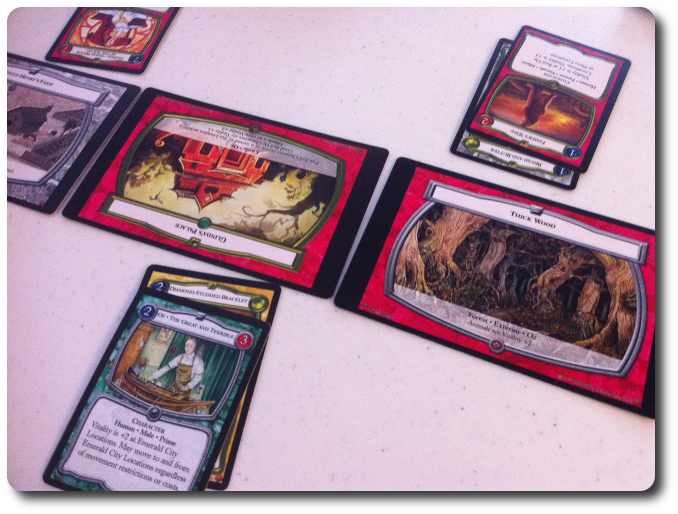
The Great and Powerful Wizard of Oz advances the story, with Glinda looking on
The Gamer Geeks were very impressed with The Card Game of Oz, especially when their initial assumption of the game, based on its title, was less than positive. “I must admit, Cyrus, this game surprised me. I thought this would be a really weak game with Oz layered on top of it to help it sell. But this? This is awesome!” When I asked what was so “awesome” about it, they stated they liked how players worked on the same Storyline that acted as a shifting board on which they placed their Characters. They could manipulate this “board” and even reset it, as well as determine when the game would end. The key to victory was proper timing and matching the best Character card with the most beneficial Location card, while at the same time making sure their opponent couldn’t . They rather liked that. While they found the game to be very light at times, they had no problem approving it. According to one Gamer Geek, “It’s no ASL, but it made me think and smile.”
The Card Game of Oz is an outstanding game, and with the Story Packs that will introduce new characters, new adventures, and new Locations, the game has a lot of room to expand. What is available now is a lot of fun to play, but the Gamer Geek in me is impatient for more. The idea that players can customize their own Library and Location Folios is very intrigue and the entire game has me wanting to read the Oz books (again) to refresh my memory of all the awesomeness that is to come.
The Storyline Game System that is the backbone of The Card Game of Oz is very flexible and intuitive. The cards in the game all work very well with each other with a number of game changing combos available to the savvy player. For example, the mass removal of all the Characters except those who are on a blue card! All I ever experienced and observed while playing the game were happy and challenged players who were also strangely absorbed in the story they were simultaneously creating and destroying. Players who are better card players and tacticians will almost always win, but even the most “newbie” of our players had no problem holding their own and making points. The game is easy to approach, easy to play, and rewarding. An excellent mix of what I would consider tried and true game mechanisms in a new setting that invites the players to explore, conquer, and control. All the while, a wonderful story of daring deeds and dark acts in the Land of Oz unfold before the players to both amuse and befuddle.
This game was given to Father Geek as a review copy. Father Geek was not paid, bribed, wined, dined, or threatened in vain hopes of influencing this review. Such is the statuesque and legendary integrity of Father Geek.




Cyrus,
Thanks for the Seal of approval and you glowing review that validates my vision for the game. What really got me was that your son now wants to read the books. That’s part of my sinister plan with this game: More Reading!
One BIG mistake however, is that the swingle Story Pack you got for review is not everything in the box. There are 4 packs for about 230 cards in the box. Could you please make that correction in your review?
Thanks again,
Jim O’Connor, Orion’s Bell
Whoops! That VERY important fact escaped me in the review material, Jim. I have corrected the error in the review to now correctly reflect what the game will reportedly be comprised of. Thanks for the correction!